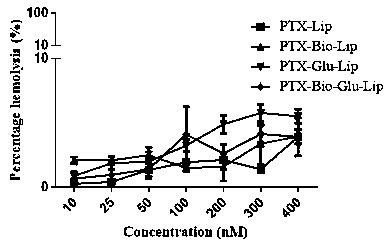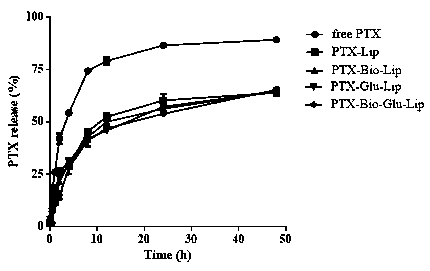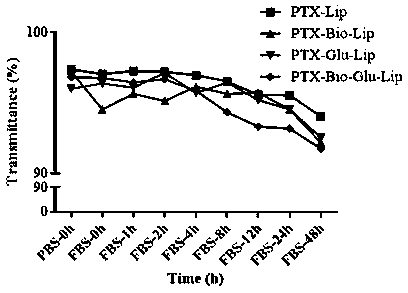Preparation and application of breast cancer targeted liposome modified by biotin and glucose
A technology targeting lipids and glucose, applied in the field of medicine, can solve problems such as limited improvement
- Summary
- Abstract
- Description
- Claims
- Application Information
AI Technical Summary
Problems solved by technology
Method used
Image
Examples
Embodiment 1
[0034] Preparation of compound 2
[0035] Benzyl alcohol (8.91 g, 82.44 mmol), succinic anhydride 1 (7.50 g, 74.94 mmol), 4-dimethylaminopyridine (91.5 mg, 0.75 mmol) were added to 60 ml tetrahydrofuran. After gradually raising the temperature to 50°C, the reaction was heated and stirred in an oil bath for 5 hours. The solvent was evaporated under reduced pressure, and the residue was dissolved in 150 ml ethyl acetate, washed successively with saturated sodium bicarbonate dilute hydrochloric acid (60 ml × 2), saturated aqueous sodium chloride solution (60 ml × 2), and dried over anhydrous sodium sulfate The organic layer was concentrated under reduced pressure and then recrystallized from isopropyl ether-acetone to obtain 9.5 g of white solid with a yield of 60.98%. Mp: 60-62°C.
Embodiment 2
[0037] Preparation of Compound 4
[0038] Anhydrous glucose 3 (9.01 g, 0.05 mol) was dissolved in 250 ml of pre-dried pyridine under ice bath conditions. Trimethylchlorosilane (38.03 ml, 0.30 mol) and hexamethyldisilazane (31.44 ml, 0.15 mol) were mixed, slowly added dropwise to the above pyridine solution containing glucose, and stirred at room temperature for 24 hours. Pyridine was evaporated under reduced pressure, 300 ml of water was added to the residue, the aqueous layer was extracted with ether (150 ml × 2), the organic layers were combined, washed with water and saturated aqueous sodium chloride solution (200 ml × 7), dried over anhydrous sodium sulfate, The solvent was removed under reduced pressure to obtain 25.38 g of a yellow oil with a yield of 93.80%. The product can be directly subjected to the next reaction without further purification.
Embodiment 3
[0040] Preparation of compound 5
[0041] Dissolve compound 4 (6.00 g, 11.09 mmol) in a mixed solution of acetone and methanol (5:8, 39 ml), and slowly add acetic acid (1.15 ml, 20.05 mmol) into acetone and methanol (v / v = 5 / 8, 3.9 ml) mixed solution. After dropping, the reaction solution was moved to room temperature and continued to stir for 2.5 hours. TLC monitored the completion of the reaction, and sodium carbonate powder (1.80 g, 17.00 mmol) was added to continue stirring at room temperature for 25 minutes. The white solid was filtered off, the filtrate was concentrated under reduced pressure, and the residue was purified by flash silica gel column chromatography to obtain 3.76 g of a colorless oil, with a yield of 72.38%. 1H NMR (400 MHz, CDCl 3 , ppm) δ:0.14-0.19 (m, 36 H), 3.35 (d, 1 H, Hz, J = 9.2 Hz), 3.66 (t, 1 H, J = 9.2Hz), 3.68 (dd, 1 H, J 1 = 4.8 Hz, J 2 = 12.0 Hz), 3.73-3.76 (m, 2H), 3.80 (t, 1H, J = 8.8 Hz), 5.16 (d, 1 H, J = 3.2 Hz).
PUM
| Property | Measurement | Unit |
|---|---|---|
| wavelength | aaaaa | aaaaa |
| dispersity | aaaaa | aaaaa |
Abstract
Description
Claims
Application Information
 Login to View More
Login to View More - R&D
- Intellectual Property
- Life Sciences
- Materials
- Tech Scout
- Unparalleled Data Quality
- Higher Quality Content
- 60% Fewer Hallucinations
Browse by: Latest US Patents, China's latest patents, Technical Efficacy Thesaurus, Application Domain, Technology Topic, Popular Technical Reports.
© 2025 PatSnap. All rights reserved.Legal|Privacy policy|Modern Slavery Act Transparency Statement|Sitemap|About US| Contact US: help@patsnap.com



